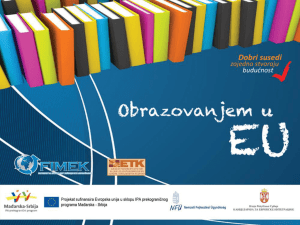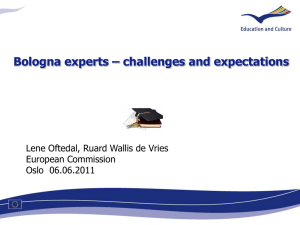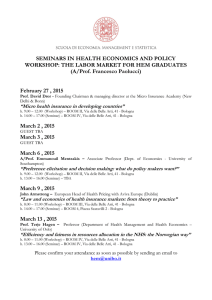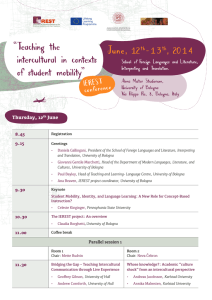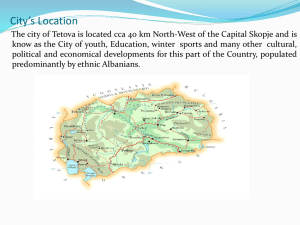the PowerPoint Presentation
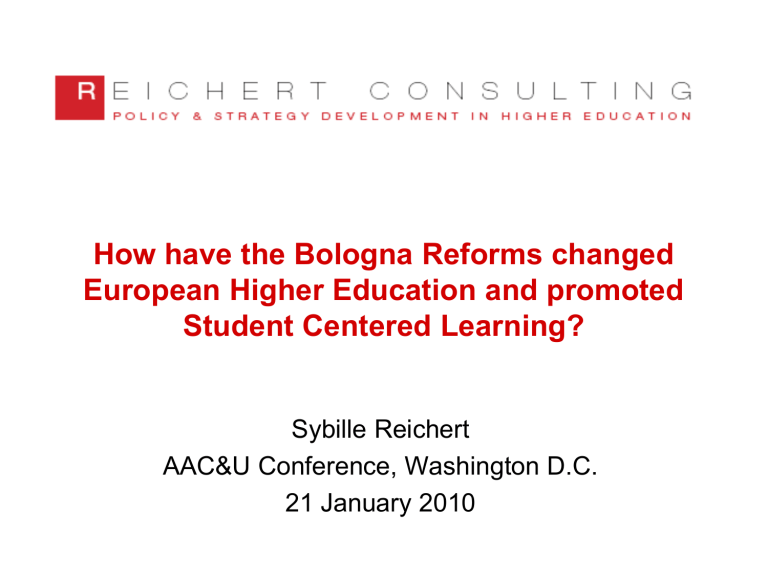
How have the Bologna Reforms changed
European Higher Education and promoted
Student Centered Learning?
Sybille Reichert
AAC&U Conference, Washington D.C.
21 January 2010
Bologna Declaration (1999): Key Motivations
Insufficient ability to adapt to demands of massified HE
High-drop-out rates,
Long study duration
Insufficient attention to diverse needs and qualifications
High unemployment of HE graduates – employability?
Increasing participation rates exploding cost? Bachelor sufficient for labour market entry?
Fragmented HE landscape with different degree structures and lengths, not readable Lack of attractiveness
European Mobility had reached a threshold (with remaining widespread recognition problems)
European citizenship with sufficient intercultural competence and European identification?
Build common market for European graduates and researchers
The European Higher Education Area: A Vision
Increase the readability of the degree structures and their contents to help mutual recognition and mobility (intercultural competences in a global world)
Increase the flexibility of learning paths to take account of diverse student profiles and needs
Move from teacher-centered to student-centered perspectives in teaching and curricular design: structured around student qualifications and learning outcomes
Enhance quality development and assurance and trust among the agencies / systems to allow for mutual recognition
Create a common market of European graduates (incl.
PhDs) for more effective, more competitive, more cooperative and international, globally responsive knowledge economies
The Bologna pan-European Reform Process
A voluntary process: Inter-Governmental process without contractual commitment & but dense sectordriven follow-up process -- policy development through soft norms; compliance through peer pressure helped by National Reports & “Stocktaking”
46 countries signed up
Reforms at national and institutional level, linked with other national and European reform agendas
Shared responsibility : governments, universities, staff
& students (Bologna Follow-Up Group, national implem.)
Every 2 years: Joint Ministerial Meeting &
Communiqué
Bologna Action Lines: The Agenda
1. Adoption of a system of easily readable and comparable degrees , based on two cycles, to be supported by European and
National Qualification Frameworks (since 2005)
2. Establishment of a system of credits (ECTS)
3. Promotion of mobility
4. Promotion of European co-operation in quality assurance, 2005: formulation of European standards and guidelines for internal and external QA (for HE institutions and agencies), 2008: launch of
European register of recognised QA or accreditation agencies
5. Promotion of the European dimension in higher education
6. Promotion of lifelong learning (since 2001)
7. Social dimension of HE (HE as public responsibility, widening access, scholarships) and student participation
8. External dimension of Bologna Process
9. Doctoral studies (since 2003) linking higher education and research (also part of European research reforms (Lisbon Agenda)
Moving to Student-centered Education and „Flexible Learning Paths“
Learning outcome descriptions (in terms of knowledge competences and skills) at all levels:
ECTS course descriptions
programme descriptions
national level descriptors in National Qualifications
Frameworks
European Qualifications Frameworks
ECTS as work-load based credit accumulation system
Transparent Recognition Procedures (Lisbon
Convention) – non-recognition has to be justified in terms of substantial difference of qualification
Different levels for learning outcomes
European, generic
Institutional, detailed
Dublin
Descriptors
(3 levels)
National descriptors
Qualification descriptors
Programme – module descriptors - ECTS
National, generic
Assessment criteria
…7…
Moving to Student-centered Education and „Flexible Learning Paths“
Reform of teaching methodologies
Expansion of student counselling and information support services
More attention to diverse student needs in QA processes, incl. student participation in quality assurance
More choices to combine Bachelors and Masters of different orientations (tracks, major/minor combinations)
Institutional attention to employability at all levels (incl. doctoral)
Smoother transitions / transparent recognition between institutions of different types
Expansion of accreditation of prior learning/ experience
Building Blocks of the
European Qualifications Framework for EHEA
Cycles
EQF-EHEA
Learning
Outcomes
(Dublin
Descriptors)
ECTS Credits
Aims: Transparency, Flexibility, Mobility
…9…
Successful Introduction of 3 Cycle System?
85-100% (35)
70-85% (3)
Source: EUA, Trends 2010 report
Yes, but the depth of the reforms varies greatly between countries and institutions: student-centered teaching and increased flexibility of learning paths are still lacking and are often being introduced as a second step rather than as
10 a structuring principle of curricular reform!
?%
Learning Outcomes at more than 80%
Higher Education Institutions
69% HEI have modularised their programs
?%
Important Successes of the Bologna Reforms
More exchange and dialogue with external stakeholders on expectations and competences – attention to employability
More (but still insufficient) attention to student-centered education, student services, counselling and tutoring opportunities, transition paths between institutions Greater flexibility of student learning paths
Strengthened curricular and institutional coherence
Much more attention to robust internal and external quality assurance, common methodology, incl. more international benchmarking of institutional offer and developments
Greater institutional autonomy in many European countries
More institutional “positioning” (internationally attractive master programmes and graduate schools, consortia, marketing)
15
Opportunities for the US
Longer experience with student-centered teaching and learning (no mentality change needed) and with definition of learning outcomes
Culture/heritage of flexibility, positive encouragement and upward social mobility: Long tradition of facilitating transitions
Easier to develop appropriate assessment and recognition methods
Easier to develop meaningful and reliable competence profiles of programmes
Easier communication between institutions across the country (common language, common heritage)
Easier to develop modalities which facilitate mobility between programmes, institutions, states, incl. mutual recognition and qualifications frameworks
Potential to develop a more permeable socially inclusive system, with more opportunity for upward mobility
Threat: increasing financial and social stratification?
The Bologna Process
What U.S. Higher Education
Has to Learn from the Bologna Process
And Why It Matters For Our Students
That We Learn It
A Threat—or an Example?
Threat!
Europe wants to regain status as world’s premier higher educator
Europe wants to attract more of the world’s international students
Europe wants its students to enjoy a competitive advantage
Example!
Europe’s higher education priorities are ones largely shared in the U.S.
Europe’s approach is more systematic, coherent, urgent
Europe faces many of the impediments that stand in the way of U.S. reforms
Shared Pursuits (1)
EUROPE
Implement 3-cycle degree structure throughout Europe
Use “Tuning” to develop outcomes consensus discipline-by-discipline
Develop “accountability loop” around European, national outcomes frameworks
U.S.
Improve transparency, comparability of U.S. degrees
Work within disciplines to ensure consistency and accountability
Enhance accountability using outcomes framework to improve effectiveness
Shared Pursuits (2)
EUROPE
Restore European eminence in higher education
Pursue “social dimension” in higher education
Support student mobility and competitiveness with lucid credentials and a barrier-free continent
U.S.
Maintain international prominence as world’s higher educator
Ensure commitment to access = success
Support student mobility and competitiveness with lucid credentials and barrier-free nation
Shared Pursuits (3)
EUROPE
Create single registry as authority for credentials
Encourage international enrollments by assuming burden of proof
Develop collaborative programs across borders
U.S.
Create common standard for state data bases
Maintain international enrollments by moving to shared standard
Develop collaborative programs across borders
Concerns for Bologna
Tight focus on higher education as engine for economic growth overlooks individual selfrealization, expansion of knowledge, social stability
Many European nations practicing à la carte approach to implementation
Many employers not “buying” the new threeyear baccalaureate
Mobility has increased only marginally
“Social dimension” receiving lip service
Concerns for U.S.
Tight focus on higher education as engine for economic growth overlooks individual selfrealization, expansion of knowledge, social stability
From state to state, different reform priorities
Many employers dissatisfied with baccalaureate recipients
Mobility impeded by increased bound admissions practices out-of-state tuitions, differing admissions standards, time-
“Social dimension” undermined by recession
Implications?
Bologna Process pursuing reforms that are also U.S. priorities—but “braids” them into multi-faceted commitment within explicit time frame
Bologna accomplishments throw spotlight on
U.S. issues
Reports on Bologna may prompt U.S. leaders to seek accelerated higher education reform
Challenges?
Bologna
Three-year baccalaureate
U.S.
Why a four-year baccalaureate? Why liberal education?
Enhanced student mobility in Europe
“Overarching” framework of higher education outcomes
U.S. barriers growing higher?
Overabundance of duplicative reform efforts?
Diploma supplement Proliferation of arcane credentials?
Challenges?
Bologna
Search for common higher education vocabulary
Tuning focus on
“learning”
U.S.
Higher education increasingly inscrutable?
Focus on “teaching” still dominant in academy?
Student-Centered initiatives worth considering (1)
Create lucid national hierarchy of learning outcomes
Clarify, assure, articulate benefits of liberal arts education
Create common standard for accessible documentation of educational results
Enable students to provide more informative documentation of competences and accomplishments
Student-Centered initiatives worth considering (2)
Examine every paradigm: courses, terms, credit hours, grades, etc.
Lead in creating standard international nomenclature
Enhance mobility—across state lines and internationally
Enhance access—and make it meaningful
Celebrate, promote, embed diversity
Encourage progress through degrees
AAC&U January 21
st
2010
Tim Birtwistle
The Sequence
1. Where do we need to be?
2. How did we get where we are?
• Key data on US Higher Education
• Elements of the Bologna Process
• “Tuning” and the US pilot project
3. What makes this work different?
5. Where might all of this lead?
Why Urgent
LUMINA’S BIG GOAL: TO INCREASE THE % of
AMERICANS WITH HIGH-QUALITY DEGREES AND
CREDENTIALS
LABOR MARKET WILL REQUIRE IT
THE KNOWLEDGE-BASED ECONOMY IS THE
FUTURE & KNOWLEDGE IS MAINTAINED THROUGH
STUDENTS
GLOBAL COMPETETIVENESS
SIGNIFICANT EUROPEAN HIGHER EDUCATION
REFORM (& worldwide interest and acceptance)
Lessons from Data
“Lies ************** and statistics” or imperfect but telling a story?
Examples of data:
• OECD: Education at a Glance
• US Census and federal data
• College Board: Coming to Our Senses
• TIMSS: math & science (grades 4 & 8)
System and individual student achievement a concern.
Caveats noted!
The United States is STUCK! Graduation rates for college students (OECD countries)
Japan Releasing system, institutional
Korea 83
91
Greece
United Kingdom
Netherlands
Belgium
Spain
76 experiment in borrowing
74
Turkey
Germany
Finland
Portugal
Bologna Process
68
67
71
Australia
Poland 66
65 Austria
Czech Republic
Hungary
Sweden
Holiday Hart McKiernan
65
64 Senior Vice-President & General Counsel, Lumina
New Zealand
United States
Mexico
Tim Birtwistle
54
54
Professor of the Law & Policy of Higher Education
Leeds Metropolitan University, U.K.
Expenditures per student, 2004
Instructional and non-instructional
Source: OECD 2007
25,000
20,000
10,000
Releasing system, institutional and personal potential – an
15,000 experiment in borrowing methodology from the European
Bologna Process
5,000
0
Holiday Hart McKiernan
Senior Vice-President & General Counsel, Lumina
U ni te d
S ta te s
S w itz er la nd
S w ed en
D en m ar k
N or w ay
A us tra lia
A us tri a
N et he rla nd s
Fi nl an d
G er m an y
Ja pa n
B el gi um d
K
U ni te in gd
Fr an ce
Ire la nd pa in
Ic el an d
N ew
Ze al an d
P or tu ga l
Ita ly
H un ga ry
K or ea
C ze ch
R
S ep ub lic k
R ep lo va ub lic
M ex ic o
G re ec e
P ol an d
Tu rk ey
Professor of the Law & Policy of Higher Education
Leeds Metropolitan University, U.K.
H.E. Reform
…………………
.?
Tuning and Bologna
and personal potential – an experiment in borrowing methodology from the European active learning outcomes
Bologna Process reference points and points of comparison
• is a process – it continues, evolves, updates, adapts and
Holiday Hart McKiernan understanding of what students:
Tim Birtwistle
Leeds Metropolitan University, U.K.
Tuning USA Pilot Details from 2009
• Releasing system, institutional
• and personal potential – an
• experiment in borrowing methodology from the European physics) Bologna Process
• 20+ institutions (2 Year, 4 Year,
Public/Private)
Senior Vice-President & General Counsel, Lumina
Tim Birtwistle
Professor of the Law & Policy of Higher Education
Leeds Metropolitan University, U.K.
Action to date
• Releasing system, institutional
• and personal potential – an
• experiment in borrowing
• methodology from the European
Employer engagement }
Bologna Process
• Cross-sector engagement
• National (press) and international interest (Australia, Bologna signatories,
European Union)
Leeds Metropolitan University, U.K.
Think Global – Act Local
Examples of U.S. “Push back”
• Releasing system, institutional
• and personal potential – an
• experiment in borrowing
• methodology from the European
Bologna Process
• “Impossible in such a diverse system”
• “Credit transfer not a problem”
• “The US is already No. 1”
Professor of the Law & Policy of Higher Education
Leeds Metropolitan University, U.K.
How Does Tuning Differ?
(Lumina Foundation survey of state team leaders and faculty)
•
Involves talking about student learning across different institutions (to get consistency among institutions)
• Creates meaningful relationships between faculty members from different institutions (talking to people from all sectors, share experience and ideas)
• Increases focus on general competencies – existing approaches mainly focus only on subject matter mastery
• Involves employers/alumni + faculty/students in thinking about what degrees represent
• Shifts focus from what’s taught to what students must learn
•
Makes explicit the implicit expectations of previous work
• Ties the academic process to academic, workforce and societal expectations
• Led by faculty and a defense against accountability from above
Where are the boundaries?
- Need to ratchet up from level to level (Verbs!)
- Need to express where one level ends and the next begins in terms other than credit hours
- Need to be able to navigate through the system
- Need defined learning outcomes
Doctoral Degree
Master’s Degree
Bachelor’s Degree
Associate’s Degree
For more information
Releasing system, institutional and personal potential – an the Tuning USA pilot at this conference.
experiment in borrowing
• methodology from the European
Bologna Process
• tuning.unideusto.org/tuningeu/
Senior Vice-President & General Counsel, Lumina
Professor of the Law & Policy of Higher Education
Leeds Metropolitan University, U.K.
